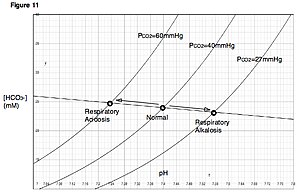Respiratory alkalosis
| Respiratory alkalosis | |
|---|---|
 |
|
| Davenport diagram outlines pH and bicarbonate levels | |
| Classification and external resources | |
| Specialty | endocrinology |
| ICD-10 | E87.3 |
| ICD-9-CM | 276.3 |
| DiseasesDB | 406 |
| MedlinePlus | 000111 |
| eMedicine | med/2009 |
| MeSH | D000472 |
Respiratory alkalosis is a medical condition in which increased respiration elevates the blood pH beyond the normal range (7.35-7.45) with a concurrent reduction in arterial levels of carbon dioxide. This condition is one of the four basic categories of disruption of acid-base homeostasis.
There are two types of respiratory alkalosis: chronic and acute as a result of the 3-5 day delay in kidney compensation of the abnormality.
Signs and symptoms of respiratory alkalosis are as follows:
Respiratory alkalosis may be produced as a result of the following causes:
The mechanism of respiratory alkalosis generally occurs when some stimulus makes a person hyperventilate. The increased breathing produces increased alveolar respiration, expelling CO2 from the circulation. This alters the dynamic chemical equilibrium of carbon dioxide in the circulatory system. Circulating hydrogen ions and bicarbonate are shifted through the carbonic acid (H2CO3) intermediate to make more CO2 via the enzyme carbonic anhydrase according to the following reaction: This causes decreased circulating hydrogen ion concentration, and increased pH (alkalosis).
...
Wikipedia

